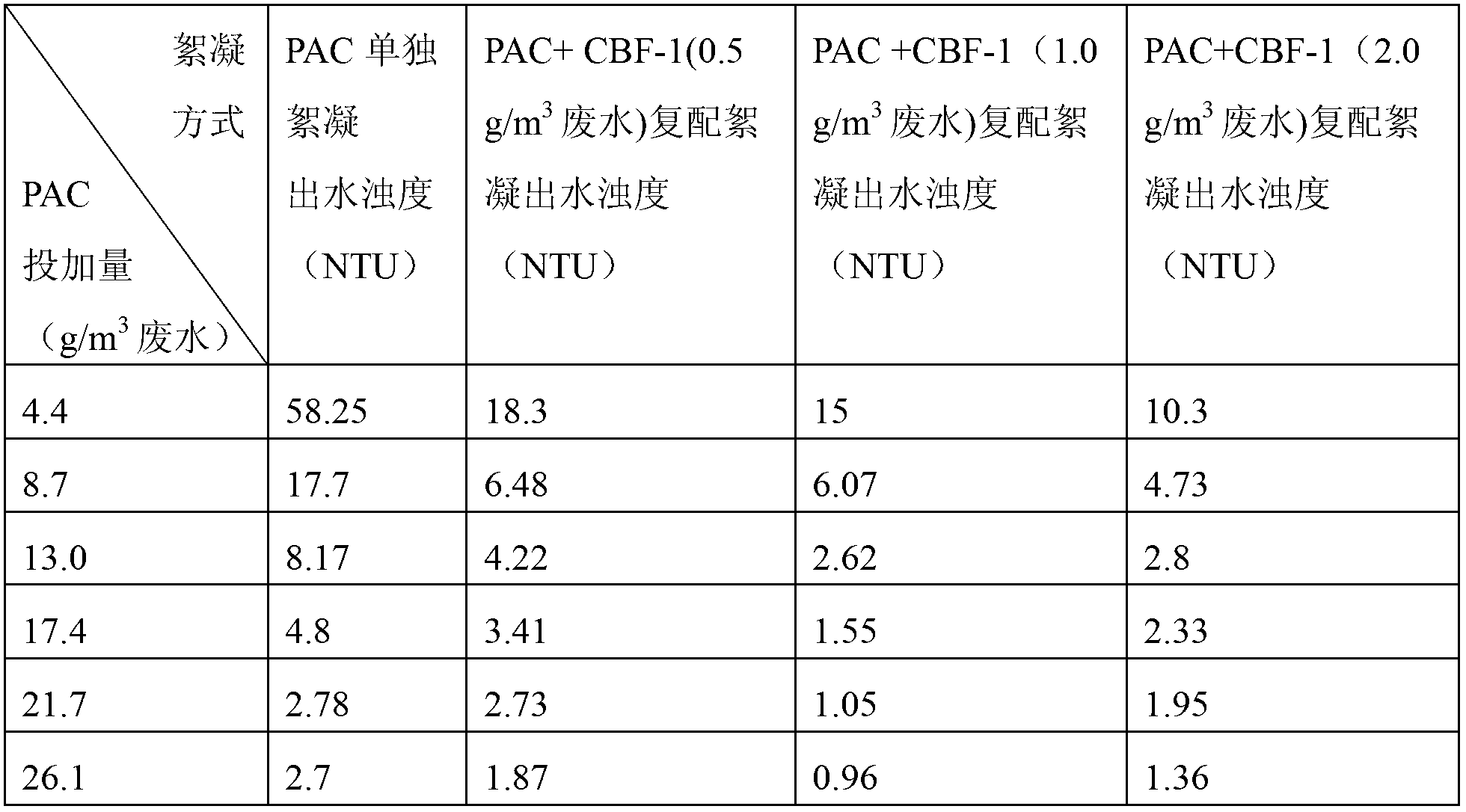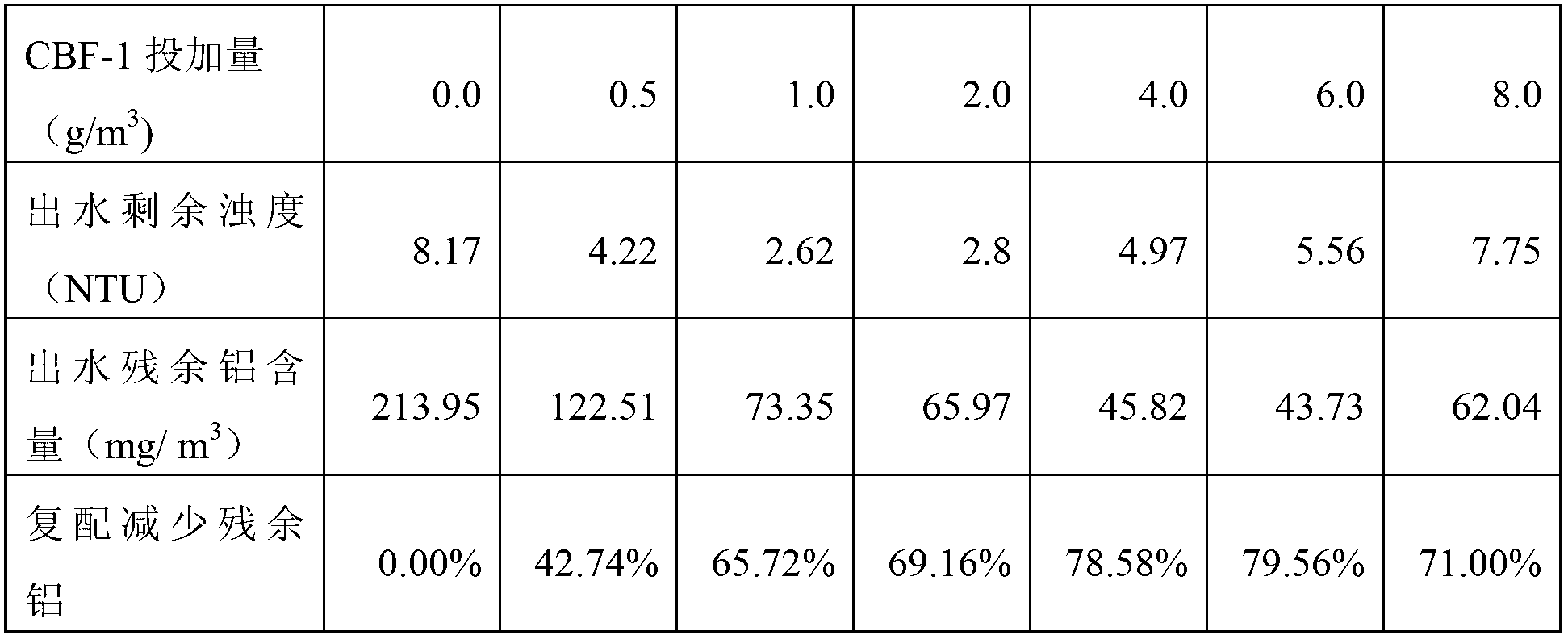Compound biological flocculant as well as preparation method and application thereof
A biological flocculant and microbial flocculant technology, which is applied in the field of water treatment, can solve the problems of difficult control of the types and proportions of active ingredients, and achieve the effects of environmental friendliness, good flocculation effect, and low residual turbidity
- Summary
- Abstract
- Description
- Claims
- Application Information
AI Technical Summary
Problems solved by technology
Method used
Image
Examples
Embodiment 1
[0031]A composite biological flocculant, which is prepared by compounding microbial flocculants and natural plant rubber powder modified anionic polymer flocculants, and its main active ingredients are acidic polysaccharides and anionic cellulose synthesized by microorganisms.
[0032] The microbial flocculant is produced by fermentation of the flocculant-producing fungus Aspergillus fumigatus HHE-A8 isolated from sludge in our laboratory. Its preparation method is as follows:
[0033] (1) Preparation of the seed solution of the flocculant-producing bacteria: insert the activated spores of Aspergillus fumigatus (Aspergillus fumigatus) HHE-A8 into 50mL of the sterilized seed solution medium, and place them on a shaking table at a temperature of 30°C. The seeds were obtained by culturing for 2 days.
[0034] (2) Fermentation production of flocculant: draw 0.1mL from the spare spore suspension of Aspergillus fumigatus (Aspergillus fumigatus) HHE-A8 and put it into a 250mL Erlenm...
Embodiment 2
[0049] Improvement of PAC flocculation effect by compound flocculation of PAC+CBF-1
[0050] This example studies the effect of CBF-1 and PAC compound flocculation of kaolin suspension in Example 1, and compares the superiority of CBF-1+PAC compound flocculation with PAC flocculation alone. In this embodiment, every m 3 The amount of PAC added to the kaolin suspension is 4.4~26.1g, and the amount of CBF-1 added is 0.5~2.0g.
[0051] Because the polymers with carboxyl groups, hydroxyl groups, phosphoric acid groups, etc. in CBF-1 can absorb and bridge with the hydroxyl polymers of kaolin and PAC to promote the formation and growth of flocs, thereby improving the flocculation performance of PAC. It can be seen from Table 2 that the coagulation aid of CBF can significantly enhance the turbidity removal performance of PAC. Such as PAC (4.35g / m 3 ~8.70g / m 3 )+CBF (0.5g / m 3 ~2.0g / m 3 ) The turbidity removal rate of the compound flocculation is 13.6%~114.9% higher than that of ...
Embodiment 3
[0056] PAC+CBF-1 compound flocculation to reduce residual aluminum content in effluent
[0057] This example investigates the change of residual aluminum content in the effluent of PAC+CBF-1 compound kaolin suspension. and at every m 3 In the kaolin suspension, the dosage of PAC was fixed at 13g, and the dosage of CBF-1 was 0.0~8.0g.
[0058] PAC is a commonly used inorganic coagulant, but the unreacted part will remain in the water body during the coagulation process, so that there will be residual aluminum in the coagulation water. There are reports that the aluminum element in the water body is harmful to plants and humans. Negative Effects. In this study, it was found that PAC+CBF-1 flocculation can effectively reduce the residual aluminum content in effluent. It can be seen from Table 3 that adding 0.5g / m2 to CBF-1 3 Wastewater~8.0g / m 3 In the case of wastewater, the residual aluminum content in the effluent can be reduced to 130mg / m 3 Below, realize the reduction o...
PUM
| Property | Measurement | Unit |
|---|---|---|
| Cod | aaaaa | aaaaa |
Abstract
Description
Claims
Application Information
 Login to View More
Login to View More - R&D
- Intellectual Property
- Life Sciences
- Materials
- Tech Scout
- Unparalleled Data Quality
- Higher Quality Content
- 60% Fewer Hallucinations
Browse by: Latest US Patents, China's latest patents, Technical Efficacy Thesaurus, Application Domain, Technology Topic, Popular Technical Reports.
© 2025 PatSnap. All rights reserved.Legal|Privacy policy|Modern Slavery Act Transparency Statement|Sitemap|About US| Contact US: help@patsnap.com



